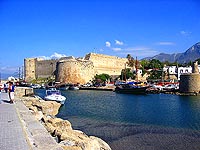
History of Kyrenia North Cyprus from 10th century BC to current modern times.
 |
the north cyprus travel guide |
 |
|
History
Historic Kyrenia (Girne) in North CyprusProbably the prettiest town on the North Cyprus coast, Kyrenia has a varied and rich history well worth exploring during your holiday in North Cyprus. History of Kyrenia, North CyprusKyrenia was probably founded by settlers from the Achaean area of Greece in the 10th century BC, and grew to become a prosperous city-state. Taken over by its rival Salamis in 312 BC, the port continued to be important throughout Roman times. The fascinating extent of the goods that flowed in and out of Kyrenia harbour were revealed when a shipwreck dating from the fourth century BC was discovered in the waters just outside Kyrenia harbour. The remains of the ship and its cargo are now on show in the Shipwreck Museum in Kyrenia Castle. Kyrenia City Walls, Northern CyprusArab raids during the 7th century prompted the citizens to construct walls around the town, but they were largely ineffectual. In 1191, the ruler of Cyprus Isaac Comnenus sent his wife and daughter to the castle at Kyrenia for safety against the forces of Richard the Lionheart. However, the castle surrendered when faced with the might of the forces behind Guy de Lusignan. Guy rebuilt the castle, and it was made into a royal palace during the reign of Hugh I. After years in the doldrums of island politics, Kyrenia became a powerful town once more, and the whole defensive system was revised and improved in 1291. The winding streets behind the harbour, that you can walk and shop in today on your Northern Cyprus holiday, date from this prosperous period. Genoese and Venetians in Kyrenia, North CyprusBy 1300, the town was well defended, with a moat around the castle and the entrance to the port guarded and crossed by a protective chain. In 1373 the Genoese laid siege to Kyrenia by both land and sea, but the town and its castle held out until the Genoese were driven from the island. The new Venetian rulers modernised the defences to withstand artillery fire, rebuilding the west wall and adding new tower to the wall system. They also remodelled the harbour and moved it, creating the harbour area we can still enjoy today on a holiday in North Cyprus. However, when the Ottoman forces arrived in 1570, the castle at Kyrenia gave in without a fight, perhaps disheartened by the fall of Nicosia. Ottoman Settlers in Kyrenia, Northern CyprusAfter the Venetians were defeated in 1571, Lala Mustapha Pasha left no less than 16,000 Ottoman soldiers in Cyprus to colonise the island, and they were joined by a further 22,00 decommissioned soldiers from the mainland. The Ottoman Empire gave these settlers excellent tax breaks, especially if they were skilled craftsmen such as cobblers, weavers, farmers or masons. Many settlers came from the Black Sea area around Trabzon and Sinop. British Administration of KyreniaKyrenia's population varied according to the influence of drought and plagues, and at one stage around 1814 there were just a handful of families living there. However, by the time of the British administration, Kyrenia became a popular town for British officials to retire to. (It still is – there are several high quality property developments around Kyrenia too.) The castle was used as a prison and a police training school. After 1974 Turkish InterventionPost 1974, Turks from the Limassol area settled in Kyrenia, and Turks from the mainland also swelled the town's population. Nowadays, Kyrenia is a bustling town that radiates outwards from the historic harbour area. Modern-day Kyrenia (Girne) in Northern CyprusToday, the elegant arc of the Venetian harbour side is lined with restaurants tables, and the former carob warehouses have been converted into restaurants and shops. Kyrenia Castle is open to visitors, along with its Shipwreck Museum, and the city's Folk Museum is housed in a fine 18th century house. |
|
North Cyprus quick: holidays | flights | hotels | property | kyrenia | famagusta | photos | map | weather | history | news
All text is copyrighted by Cyprus44. Photographs are copyrighted by their respective photographers.
For more information read our copyright policy, privacy policy and disclaimer.
This web page is served on 18 September 2025 at 8:57:55 AM.
![]()
Cyprus44 in other languages: Nordzypern | Chypre Nord | Severní Kypr | Северный Кипр
partner sites: goNorthCyprus Travel | Pacific Rent-A-Car | Amy Holiday Villas | other partner sites








